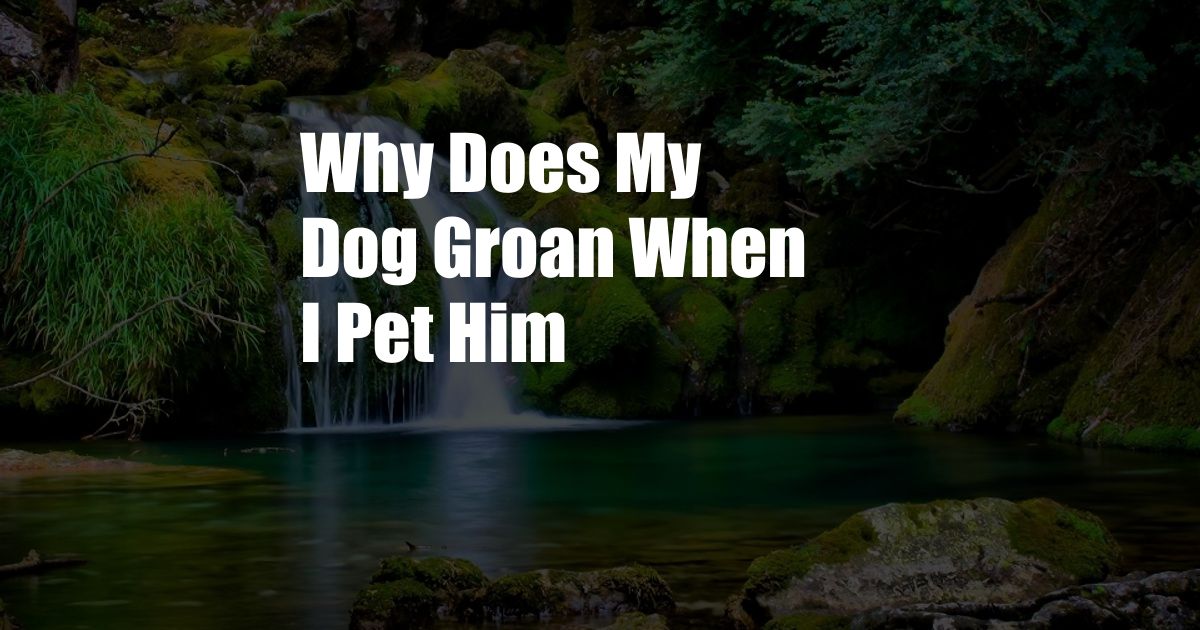
Why Does My Dog Groan When I Pet Him?
My beloved golden retriever, Buddy, was always a joy to pet. However, one day I noticed he started groaning whenever I stroked him. Initially, I was concerned about whether he was in pain, but a trip to the vet ruled out any physical discomfort. I was puzzled until I stumbled upon some fascinating information about dog behavior.
It turns out that groaning in dogs can be a sign of several different things, not all of which are cause for concern. Understanding the underlying reasons can help you better interpret your dog’s signals and build a stronger bond with them.
Communication: Expressing Discomfort or Pleasure
Groaning can be a way for dogs to communicate their current state. If your dog groans softly and briefly while being petted, it could be a sign of relaxation and pleasure. The groan may be accompanied by relaxed body language, such as closed eyes or a wagging tail.
However, if your dog is groaning loudly or continuously while being petted, especially if accompanied by other signs like a stiff posture or avoidance, it may be a sign of discomfort or pain. In this case, it’s best to stop petting and pay attention to your dog’s other behaviors to determine the cause of their discomfort.
Emotional Expression: Submissive or Stressed
Groaning can also be a way for dogs to express their emotional state. A submissive groan is usually low-pitched and accompanied by other submissive behaviors, such as licking lips, yawning, or avoiding eye contact. This type of groan is typically seen in submissive dogs or in situations where the dog feels threatened or uncomfortable.
On the other hand, a stressed groan is often higher-pitched and accompanied by other signs of stress, such as pacing, panting, or avoiding certain areas. This type of groan indicates that the dog is feeling overwhelmed or anxious and needs some space or reassurance.
Medical Conditions
While groaning is usually not a sign of a medical condition, it’s important to rule out any underlying health issues if your dog’s groaning is persistent or accompanied by other symptoms. Certain medical conditions, such as joint pain, gastrointestinal issues, or neurological disorders, can cause discomfort or pain that may manifest as groaning.
If you notice that your dog is groaning excessively, especially if it’s accompanied by other symptoms like limping, vomiting, or seizures, it’s important to consult with a veterinarian to determine the underlying cause and receive appropriate treatment.
Tips and Expert Advice for Dog Owners
Here are some tips and expert advice to help you better understand and respond to your dog’s groans:
- Observe your dog’s body language and other behaviors to determine the context of the groaning.
- If your dog’s groaning seems to be a sign of discomfort or pain, stop petting and pay attention to your dog’s other behaviors to identify the cause.
- If your dog’s groaning is accompanied by other signs of stress or anxiety, try to provide reassurance and a safe space.
- If your dog’s groaning is persistent or accompanied by other symptoms, consult with a veterinarian to rule out any underlying medical conditions.
- Be patient and understanding with your dog and try to approach petting and other interactions in a way that makes them feel comfortable and secure.
FAQs: Common Questions and Answers
Q: Why does my dog groan when I pet him on his stomach?
A: Some dogs may be ticklish or sensitive to being petted on certain parts of their body, such as their stomach or paws. If your dog groans when you pet him on his stomach, it may be a sign that he finds it uncomfortable.
Q: What should I do if my dog groans when I pet him?
A: First, observe your dog’s body language and other behaviors to determine the context of the groaning. If your dog seems to be in pain or discomfort, stop petting and pay attention to your dog’s other behaviors to identify the cause. If your dog’s groaning is accompanied by other signs of stress or anxiety, try to provide reassurance and a safe space. If your dog’s groaning is persistent or accompanied by other symptoms, consult with a veterinarian to rule out any underlying medical conditions.
Q: Is it okay to pet my dog even if he groans?
A: If your dog groans softly and briefly while being petted, it may be a sign of relaxation and pleasure. However, if your dog is groaning loudly or continuously while being petted, especially if accompanied by other signs like a stiff posture or avoidance, it may be a sign of discomfort or pain. In this case, it’s best to stop petting and pay attention to your dog’s other behaviors.
Conclusion
Groaning in dogs can be a complex behavior with multiple meanings. By understanding the different reasons why your dog may be groaning, you can better interpret their signals, respond appropriately, and build a stronger bond with them. If you’re concerned about your dog’s groaning, especially if it’s persistent or accompanied by other symptoms, don’t hesitate to consult with a veterinarian to rule out any underlying medical conditions.
So, next time your furry friend groans while you’re petting them, take a moment to observe their body language and behaviors. It may simply be a sign of contentment and gratitude, or it may be a way for them to communicate discomfort or a need for space. By being attentive and responsive to your dog’s cues, you can create a harmonious and fulfilling relationship built on mutual understanding and respect.
Are you interested in learning more about dog behavior and communication? Share your questions and experiences in the comments below, and let’s continue the conversation!